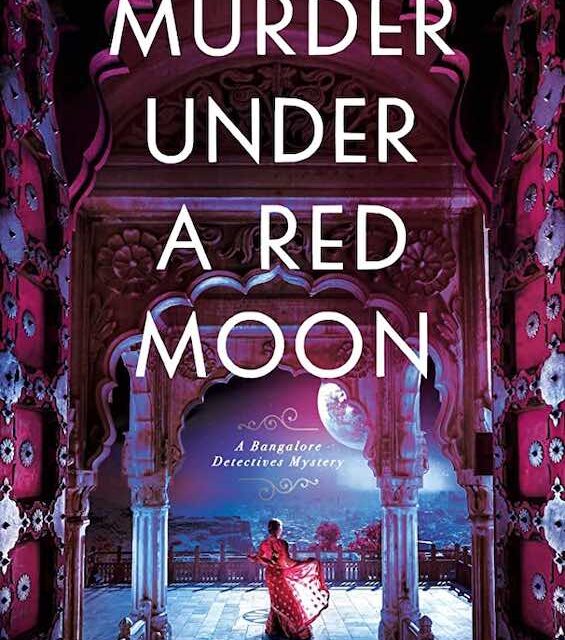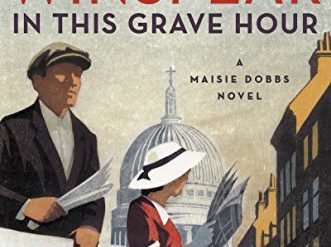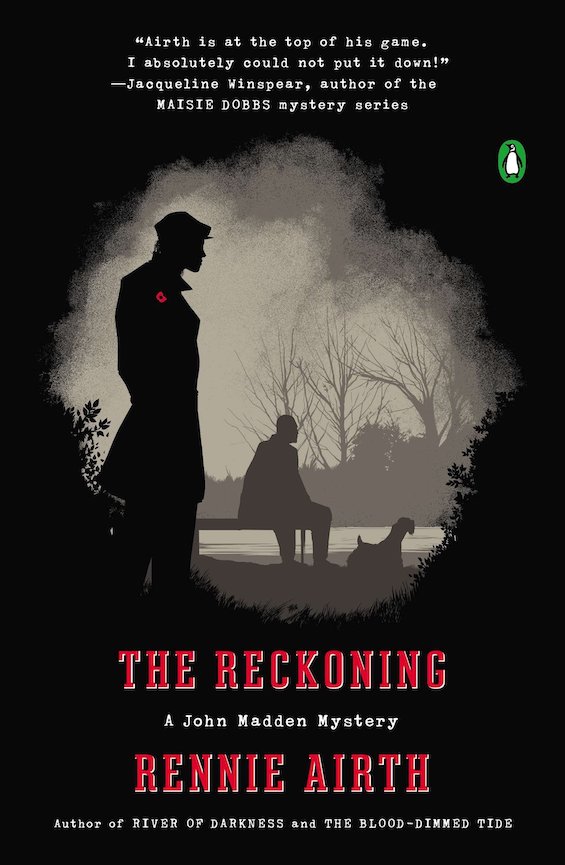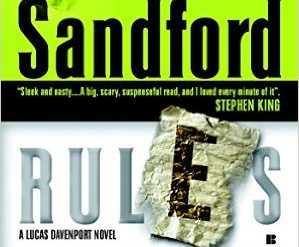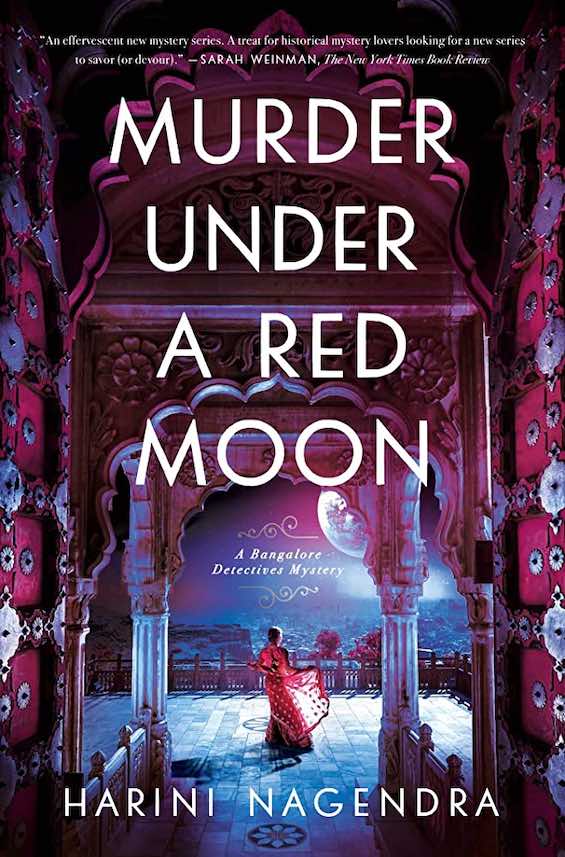
Here’s a murder mystery with an implausible plot and an unlikely heroine that’s fun and rewarding to read despite the flaws. Harini Nagendra’s Murder Under a Red Moon, her second effort about the Bangalore Detectives Club, stars nineteen-year-old Kaveri Murthy. Because she recently solved a high-profile murder in the presence of Bangalore’s elite, and later succeeded in a series of less prominent cases, Kaveri has become “a well-known and respected detective.” Now her annoying mother-in-law has pressed her into service to investigate another crime—not murder in Bangalore this time but embezzlement at the city’s largest employer. But don’t be misled by the flimsy fictional framework. Murder Under a Red Moon is historical fiction based on solid research. And it casts a bright light on life in the British Raj a century ago.
Estimated reading time: 6 minutes
A view of life in British India masked as a murder mystery
Dark themes underlie the mystery. Domestic abuse. Searing poverty. The growing cocaine trade. Racist British officials. A rigid caste system. And the corrupt “holy men” who prey on rich and poor alike. Because Bangalore in 1921, when the novel is set, was on the cusp of exploding in fury against the injustices of the British Raj. Nationwide, a million Indian soldiers were returning after combat in World War I, their expectations for change heightened by their sacrifices. Mohandas Gandhi and the Indian National Congress party were stepping up their campaign for self-rule. It was a time when traditional practices were coming into question as the modern world insinuated itself into the fabric of Indian society.
Murder Under a Red Moon (Bangalore Detectives Club #2) by Harini Nagendra (2023) 301 pages ★★★★☆

The women of the Bangalore Detectives Club
Kaveri Murthy is the public face of a small group of women who meet periodically in her home. They’re a diverse group, crossing lines of caste, class, and religion—against her mother-in-law’s wishes. Among them are a Muslim, a former prostitute, a battered wife, and Kaveri’s kindly “Uma aunty” who lives in the house next door. The young woman’s original purpose in organizing the group was to teach them how to read and write, and the tutoring continues. But as Kaveri takes on new investigations, she finds that, collectively, her pupils know just about everything that goes on Bangalore. (At the time, it was a small city, with a population of less than 250,000.) And Kaveri has come to name the group the Bangalore Detectives Club, even erecting a sign on the gate of her home.
But the group doesn’t consist entirely of women. Because Kaveri’s husband, Dr. Ramu Murthy, a prominent and wealthy surgeon, supports her in every way. And she turns to him for advice and help on a regular basis. At times, she even needs him to open doors that are firmly closed to her as a woman. And Inspector Ismail of the local constabulary, a rare Muslim within the predominantly Hindu ranks, plays a critical role in the final stages of every investigation involving criminal conduct.
What’s going on here?
Bhargavi, Kaveri’s mother-in-law, surprises the young woman by insisting she put her detective skills to work for her friend Mrs. Shanthi Sharma. We learn that “Shanthi’s husband Mr Sharma is a well-known industrialist who owns Sampangi Mills,” the city’s largest employer. But the company is in trouble because someone has been embezzling large sums of money. Bhargavi wants Kaveri to suss out the criminal. But it soon becomes clear that the case is not simple. Three suspects emerge. Shanthi’s step-daughter, Chitra, Mr. Sharma’s daughter by his first wife. Chitra’s fiancé, Kumar, the manager of Sampangi Mills. And Shanthi herself. Because Shanthi and Chitra detest each other, and Chitra is profoundly unhappy about marrying Kumar, her father’s choice for a husband. And those are just the beginning of the complications. The story only becomes more baffling when someone—I won’t spoil the story by telling you who—is murdered. And, yes, it takes place under a red moon, an occasion that sets off waves of wailing among the suspicious folk of Bangalore.
How Bangalore got a new name
For some visitors to India, the names of the cities can be a puzzle. Where is Bombay? Calcutta? Madras?—the cities that we know from reading about the country’s past. The answer is simple. No sooner did India gain its independence from Britain in 1947 than the government began systematically renaming cities and states to standardize spelling, use local languages, and better reflect history. Thus, Bombay became Mumbai. Calcutta is Kolkata now. Madras changed to Chennai. And Bangalore, where this novel is set, is now Bengaluru.
About the author

On her author website, we note that “Harini Nagendra is a professor of ecology at Azim Premji University, and a well-known public speaker and writer on issues of nature and sustainability. She is internationally recognized for her scholarship on sustainability.” The university is located in Bengaluru. Nagendra holds a BSc from Bangalore University and an MS and PhD from the Indian Institute of Science. She has over 150 scientific publications to her name and is the author of several nonfiction books in her field as well as the two books to date about the Bangalore Detectives Club.
Nagendra now lives in Bengaluru with her husband and daughter. But she was born farther south in the state of Tamil Nadu, in 1972.
For related reading
You’ll find my review of the first book in this series at The Bangalore Detectives Club (A murder case crosses class and caste lines in 1921 Bangalore). It’s also listed on The best Indian detective novels.
I also recommend two other historical mystery series set in India during the same period. Each begins with the titles that follow. (Truth to tell, they’re both better written and more plausible.)
- The Widows of Malabar Hill (Perveen Mistry #1) by Sujata Massey—The first woman lawyer in Bombay solves a baffling mystery
- A Rising Man (Wyndham and Banerjee #1) by Abir Mukherjee—A brilliant historical detective novel set in India following World War I
You might also enjoy my posts:
- Good books about India, past and present
- Top 10 mystery and thriller series
- 30 outstanding detective series from around the world
- Top 20 suspenseful detective novels
- Top 10 historical mysteries and thrillers
And you can always find my most popular reviews, and the most recent ones, on the Home Page.

